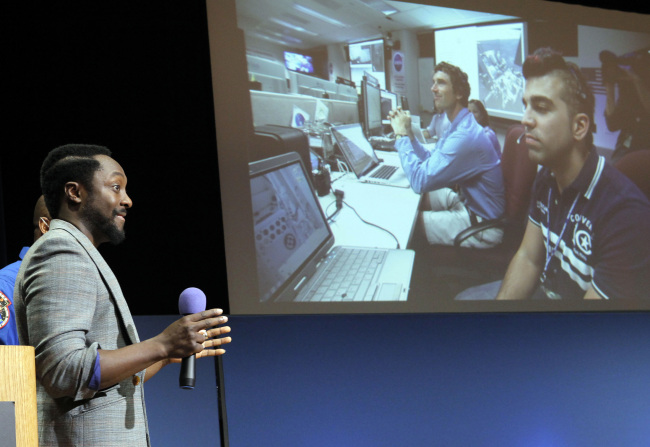LOS ANGELES (AFP) ― NASA transmitted the first song to be broadcast from Mars on Tuesday, by Grammy-winning U.S. musician will.i.am, as part of efforts to inspire young people to get interested in science.
“Reach for the Stars” was then beamed back by the Curiosity rover, which landed on the surface of the Red Planet earlier this month, to NASA’s Jet Propulsion Laboratory (JPL) in Pasadena, California.
NASA staff clapped their hands and held their arms in the air, smiling and swaying to the rhythm during the slightly less scientific use of the rover’s hi-tech equipment and communications ability.
 |
Will.I.Am, with Black Eyed Peas, speaks at Nasa’s Jet Propulsion Laboratory Tuesday, in Pasadena, California. (AP-Yonhap News) |
“It seems surreal,” the U.S. rapper and actor said explaining how NASA administrator Charles Bolden had called him to suggest beaming a song back from Mars as part of educational outreach efforts by the U.S. space agency.
The song ― with lyrics including “I know that Mars might be far, but baby it ain’t really that far” ― involved a 40-piece orchestra including French horns, rather than a more modern electronically-generated sound.
The singer said he didn’t “want to do a song that was done on a computer,” given that it was going to be the first piece of music broadcast back to the Earth from Mars.
“I wanted to show human collaboration and have an orchestra there and something that would be timeless, and translated in different cultures, not have like a hip hop beat or a dance beat,” he said.
“A lot of times ... people in my field aren’t supposed to try to execute something classical, or orchestral, so I wanted to break that stigma,” the 37-year-old ― real name William James Adams ― told a student audience.
The aim was to inspire young people like those at the NASA event, including some from Boyle Heights in East Los Angeles where the musician grew up, to take a greater interest in science.
NASA experts this week released more pictures taken by the $2.5 billion rover, which landed at Gale Crater on the Red Planet on Aug. 6.
One showed a panorama, in pin-sharp resolution showing individual rocks, of the landscape visible from the rover, including Mount Sharp, the slopes of which Curiosity plans to drive toward in the coming weeks and months.








